











A couple things changed once we got past the canyons. The weather turned colder and rainier, and good campsites were harder to find. We often ended up on gravel bars that provided rather poor holding for tent stakes. This site, though, was quite nice. It was a bit of tundra down low, right next to the river. Nice campsite but hard to get to. We had to drag the canoes a ways to get here, and our feet were good and wet by the time we got to camp. Notice also the clothing. We were now past the warm and sunny part of the trip.
Speaking of wet feet, this is a good opportunity to talk about footwear. As part of preparing for this trip, I read Cliff Jacobson's Expedition Canoing. A very helpful book but when it came to footwear, he just said that everyone has their favorite and the choices vary all over the map. Hmmm, not as helpful as I'd hoped but he did have general principles. The basic idea seemed to be either two or three pairs of footwear, one for in the canoe that might get wet, dry shoes for around camp, and maybe something separate for hiking. Some people would try to keep their feet dry while canoing with different kinds of waders or waterproof shoes while others would just go with sneakers and neoprene socks for warmth.
My choice was partly dictated by what I had on hand. I'd have bought something new if I had a clear direction on what I wanted to get but, since I didn't, I just packed what I had around the house. I took a pair of Bean boots, aka the Maine Hunting Shoe, for my canoe shoes and hiking boots for dry shoes around camp and hiking. I found this choice worked out very well for me. The rubber bottoms of the Bean boots meant that I could splash through shallow water like getting in and out of the canoe without getting wet and, if I didn't stand around too long, somewhat deeper water too. Obviously when the water was over my knees, my feet got wet but then I was just in the same boat (so to speak) as the people wearing sneakers. So, overall, I was very pleased with my footwear choice.
Another interesting bit of footwear on the trip was a pair of Wiggy's lightweight waders that Andy brought. Before the trip, we wondered how good the footing would be, if your foot would slip around in the bottom of the wader, but Andy reports they worked quite well. Their size and weight are great and I'm thinking I ought to get a pair for use with the float plane.






Another hiking day got some pictures that show a couple points. One is the scale, see how tiny our tents look sitting on that gravel bar. Another is you can see how the trees are thinning out as we proceed further north.















One of the more intriguing sights in the region is the smoking hills. There's a mineral called lignite in the ground that burns on contact with air and it has been smoldering away for years. When we smelled the sulphur, we knew we were getting close and when we saw the smoke plume ahead, it was time to take a closer look.
The result of this is a very weird looking ground with surprising colors from the minerals. In places we were walking through ash and it really felt like it. In some places, our footsteps would start smoking as we exposed more mineral to the air.


Robert got a bug tent to bring along on the trip and I'm not really sure anymore why it took us so long to try it out. When we did, the relief was palpable. We were able to sit inside and just relax while we ate dinner.




The weather wasn't nice all the time, I just usually didn't get the camera out on the yucky days. But here's an idea of what it was like on those days that weren't so great. We're getting pretty near the end of the trip here, there's hardly a tree to be seen anymore.

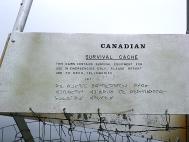
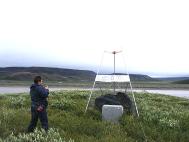
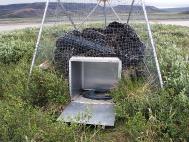
One day, while floating along, we saw this odd thing off on the bank, about 200 meters back from the water's edge. At first we thought it was an automated weather station and we decided to have a closer look. Nope, not a weather station but a survival cache.
Perhaps it's no longer maintained though, as its contents left a little to be desired if you were depending on it in a survival situation.

Along the way, I got old. Yup, I turned the big 40 in the arctic. I suppose if you have to do it, this is the place. My trip-mates kindly made me a cake, a birthday card, and pointed out how I was far from the oldest on this trip. I had a good birthday.
The next day, in fact for the next several days, the wind was just whistling, right down the river in our faces. We'd read reports of being wind-bound, written by people who'd traveled the Horton before us. This happening to us was a consideration in our planning. We didn't quite get stopped by the wind but it certainly made paddling a lot more work than we were used to.


At this point, we were one day's paddle from the end of the trip. People were cold and tired from paddling into the wind all day and we had a really hard time finding this campsite. In the end, it turned out to be a pretty reasonable campsite but it didn't look like it at first.
One exciting thing was that just across those hills you see, (they actually were hills this time), was the Arctic Ocean. You can't see it very well on the scale maps I have here, but there's a ridge running right along the edge of the ocean here and the river winds back and forth behind it, separated from the ocean until it finally breaks through.



Excited to see the Arctic Ocean, we took off on a hike. Not the best of weather, as you can see, and soon we were up in the clouds. After walking in the fog for a while and monitoring our progress with the GPS, we found we weren't getting any closer to the ocean, just paralleling it going south. We headed back to camp.


Then next day's weather was much better. Still windy as all get out, but at least the sun was out. We went down the river a quarter mile and different way across the ridge. It turned out to be a short, fairly easy hike once we had the right spot.



So there it was, the Arctic Ocean. In a way, it had been our destination the entire trip, so it was quite a sight to see. In fact, if you look carefully at these pictures, you'll see a light brown strip sticking out into the ocean. That's the river delta at the end of the Horton. While we were heading for the Arctic Ocean, that was the actual end of the river, the end of our trip.



There are even a few more smoking vents. Since the hillside was pretty steep, we didn't climb down to the ocean though we were tempted. We probably would have been able to scramble back up, it just looked like a lot of work.
Way out, right on the horizon, we could just see the edge of pack ice. With the strength and direction of the wind over the past few days, the ice would have been pushed offshore so we weren't sure if we'd see any at all.

This was also a good place for a group picture. From left to right: Andy, Eric, Robin, Robert, Marilyn, Dave.




We'd heard that some people had seen whales from the top of this ridge. My though on hearing this was, "yeah, one person saw a whale once. there's no way we're going to see any". Well, after sitting up there for a while we saw two or three whales spouting. They were far enough out that there was no chance of pictures but we'd seen whales in the Arctic Ocean. Very cool.
Then a whole pod of beluga whales swam by, just a short distance off shore. There had to be 30 or more animals in the group and we even got to see the behavior where three whales swim in a small circle around a school of fish and then all dive into the middle at the same time to eat. These were close enough to get some distant pictures of.
On the hike back down to our canoes, I took a series of five pictures to make a panorama. The view just struck me as a perfect image of the arctic. Mike Burg kindly stitched these pictures together for me to make this:


So this was our last day paddling. As we turned the final bend and headed for the Arctic Ocean, we finally got a tail wind. A really good tail wind. There were whitecaps all around us and the view in front of us looked like the river fell off the edge of the world. It almost felt like we were being pushed inexorably towards our doom.

Finding a campsite was a bit of a problem here at the end of the river. Here's what the shore looked like.




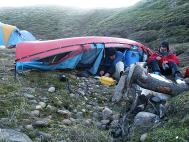
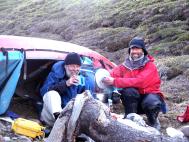
Eventually we did find a place, of course. It was in a little gully along the edge of the river. There was enough room for our tents and it was sort of level and it kept us out of the wind that was whistling across the top of the tundra. We just hoped it wouldn't rain as it looked like we'd be washed right out into the ocean if that happened.
We'd planned to arrive at the end a day early so we'd have one more day to just hike around as we wanted and also as a day of buffer in case we were delayed. We weren't delayed so we had a day to wander and see what there was to see. Robin and I walked out on the mud flats of the river delta so we could stick our hands in the Arctic Ocean.



In the first picture below, you can just barely see an abandoned DEW Line Station on the top of the ridge.
One thing I didn't take a picture of (I can't think why not since I obviously had my camera) was half a green canoe that we found out on the mud. A few days earlier we'd seen, presumably, the other half of this canoe on the river bank. Obviously there's a story there but I don't know what it is.
The canoing is over, it's pickup day. We'd called North-Wright on the sat-phone to let them know we were at the pickup location and it turns out that they'd planned to get us at the end of the day, in case we were a little late. So we sat around camp until we were bored and then packed up and sat around some more.
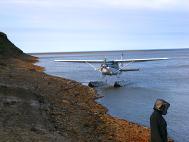
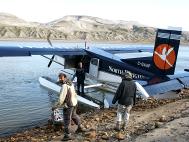
Eventually we heard a plane and there comes a Cessna 206. Uh, there are six of us and three canoes. That's just not going to carry all of us. But a few minutes later the Turbo Porter arrived and the two planes were able to carry the lot of us.
We found out that the 206 pilot was the new guy and this was his first wilderness run so the boss came along to check him out. The normal way they would have done this pickup was for the 206 to make three trips. With it being a 2-hour flight each way and loading an unloading at each end, that would have been a damned long day.
Having Warren along in the Turbo Porter solved another problem that Robin and I had been pondering. Everyone else was going to fly out of Inuvik and go home on commercial airlines. Robin and I had to get back to Norman Wells to get my plane. We'd booked a flight on North-Wright's scheduled service to close that loop but we wouldn't be allowed to bring the bear spray or white gas on that flight.
When I heard that Warren was going back to Norman Wells after dropping us off in Inuvik, I quickly repacked a bag to have the bear spray and white gas and asked him to just stick it in my plane when he got back there. Have I said already how helpful the people at North-Wright were?
We got into Inuvik about midnight and asked the guys bringing us in, just where would we be able to find food at this time of night. Of course the sun was still up so it didn't feel all that much like night. We stopped at a pizza/chinese place on the way into town and checked their hours. No problem. So Robert, Marilyn, and Andy went to a B&B while Robin, Eric, and I went to the campground. You know, the shower felt really good.
We stayed in Inuvik for a few days, getting used to civilization again and learning a little about a town that's north of the arctic circle.
One venue of note was the Mad Trapper Bar. They had a very enjoyable local band both nights we went there and you could really see the community of people that made up this place.
Soon it was time to leave and people started going their separate ways, catching various flights back south. Robin and I had tickets for one more North-Wright flight, this time scheduled service on a Cessna Caravan back to Norman Wells.
Continue with the flight home.